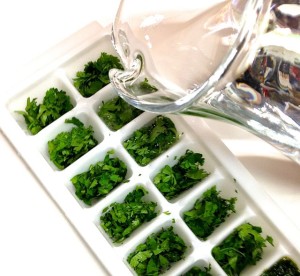Savor The Flavor
How to save herbs for winter use
by Marsha Goldberg, Fairfax Master Gardener
 For a gardener, one of summer’s great pleasures is stepping outside, snipping some fresh herbs, inhaling their pungent fragrance, and then using them in dinner that night. There is nothing that compares to fresh oregano topping a pizza or tomatoes and chopped basil drizzled with olive oil. How frustrating, then, to have to face winter without them or, more annoying, to have to pay $3 or $4 to buy a bunch of herbs at the market, use a few tablespoons, and have the rest go bad. The good news is that you can easily save most of the fresh herbs from your garden, use them throughout the winter, and save many dollars on your food bills.
For a gardener, one of summer’s great pleasures is stepping outside, snipping some fresh herbs, inhaling their pungent fragrance, and then using them in dinner that night. There is nothing that compares to fresh oregano topping a pizza or tomatoes and chopped basil drizzled with olive oil. How frustrating, then, to have to face winter without them or, more annoying, to have to pay $3 or $4 to buy a bunch of herbs at the market, use a few tablespoons, and have the rest go bad. The good news is that you can easily save most of the fresh herbs from your garden, use them throughout the winter, and save many dollars on your food bills.
Cut your herbs from plants that have not yet bolted, or flowered, since once this happens, they tend to taste bitter. The best time to cut herbs to store is in the morning, when their oils are at their peak. Have no fear; herbs will grow back once you cut them. In fact, pinching them back or cutting them will cause them to branch out and become bushier, so it is actually healthier for the plant for you to trim it. Be sure to leave some growth or leaves at the bottom of the plant from which it can send up new sprouts.

Ice cube trays can store herbs in your freezer
You can also easily dry herbs as well if you have the room for it. Cut the herbs with their stems to make them easier to handle. Be sure to rinse them well. Swishing them in water with a bit of salt in it will not only clean the herbs but bring bugs to the top, which you can then skim off. Be sure to dry the herbs thoroughly by spreading them out in a warm spot, preferably one with good air circulation. You can also lay them on a cookie sheet and put them in the sun. Once they are thoroughly dry and their color has dulled, crumble up the herbs and store them in an airtight jar until they are ready to use. Alternately, before they become too brittle, you can tie the stems together and hang them upside down in a cool, dry place and then just snip them off when you are ready to use them. Whichever method you choose, you will be able to continue to enjoy the bounty of your summer garden and punch up the flavor of your winter gourmet dishes. Bon appétit!